Volume 6, Issue 1 (Continuously Updated 2023)
Func Disabil J 2023, 6(1): 0-0 |
Back to browse issues page
Download citation:
BibTeX | RIS | EndNote | Medlars | ProCite | Reference Manager | RefWorks
Send citation to:



BibTeX | RIS | EndNote | Medlars | ProCite | Reference Manager | RefWorks
Send citation to:
Sadati S, Mohamadi R, Kamali M. Comparison of Children’s Communication Checklist Between Deaf and Hard of Hearing, and Hearing Adolescents. Func Disabil J 2023; 6 (1) : 84.3
URL: http://fdj.iums.ac.ir/article-1-221-en.html
URL: http://fdj.iums.ac.ir/article-1-221-en.html
1- Department of Speech Therapy, Rehabilitation Research Centre, School of Rehabilitation Science, Iran University of Medical Sciences, Tehran, Iran.
2- Department of Speech Therapy, Rehabilitation Research Centre, School of Rehabilitation Science, Iran University of Medical Sciences, Tehran, Iran. ,mohamadi.re88@gmail.com
3- Department of Rehabilitation Basic Sciences, Rehabilitation Research Centre, School of Rehabilitation Sciences, Iran University of Medical Sciences, Tehran, Iran.
2- Department of Speech Therapy, Rehabilitation Research Centre, School of Rehabilitation Science, Iran University of Medical Sciences, Tehran, Iran. ,
3- Department of Rehabilitation Basic Sciences, Rehabilitation Research Centre, School of Rehabilitation Sciences, Iran University of Medical Sciences, Tehran, Iran.
Keywords: Pragmatic skill, Deaf and hard-of-hearing (DHH), Hearing adolescent, Children’s communication checklist, Adolescent
Full-Text [PDF 983 kb]
(450 Downloads)
| Abstract (HTML) (1244 Views)
Full-Text: (430 Views)
Introduction
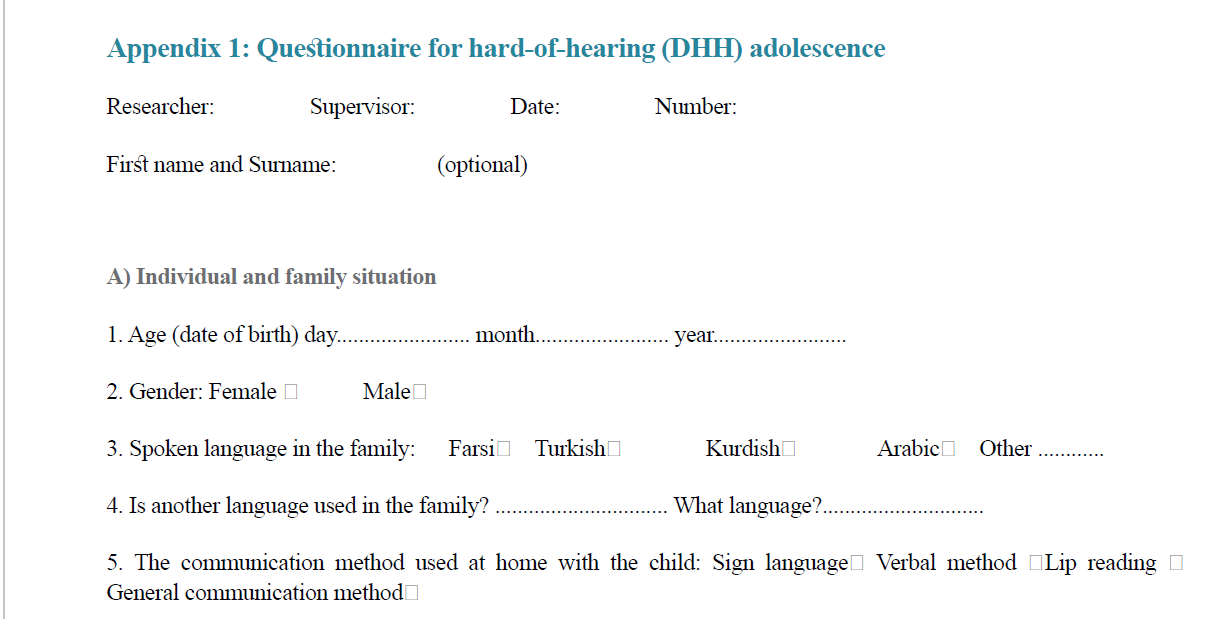
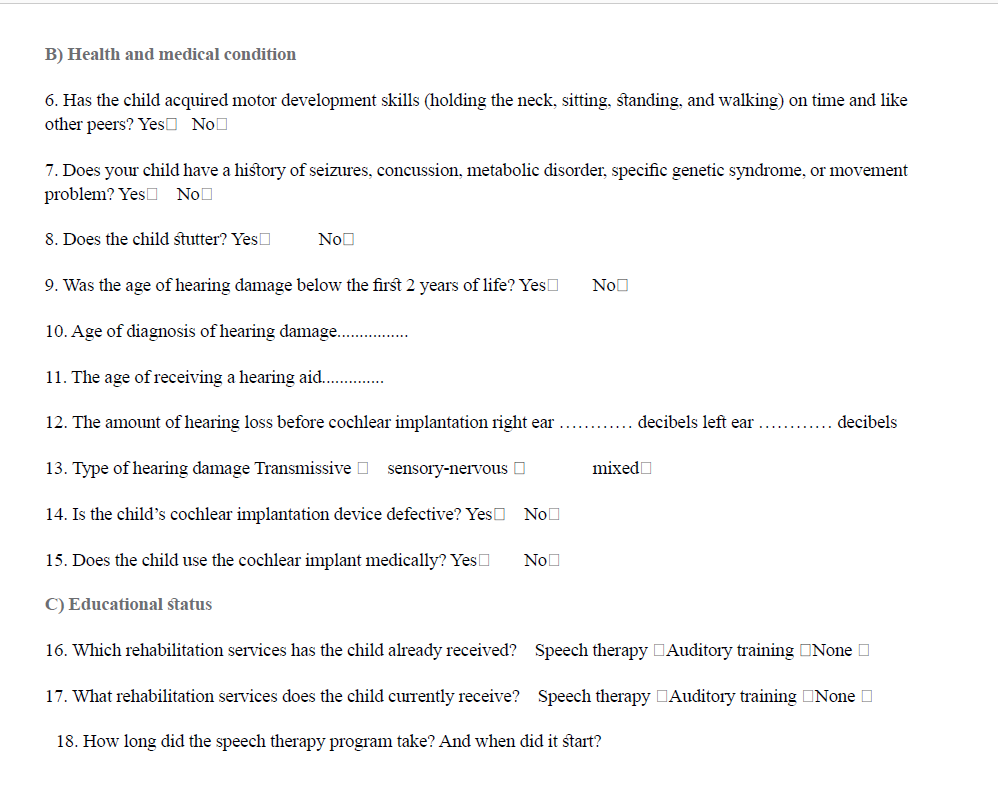
.png)
Pragmatic skills represent the rules needed for the proper and effective use of language in everyday conversations [1-3]. The vital pragmatic skills include turn-taking, topic maintenance, topic initiation, cohesion, word use, conversation repair, and clarification requests [4, 5]. Pragmatic skills develop during childhood and mature during school age [6-8]. Communication behavior in adulthood and auditory skills in childhood are closely related [9]. Pragmatic skills are also negatively affected by hearing loss [1]. Deaf and hard-of-hearing (DHH) children have been indicated to perform poorly on several pragmatic language abilities [2].
Children’s pragmatic skills have been evaluated using two different approaches [10]. The initial category relates to formal assessments that reveal crucial details about children’s pragmatic ability under formal, controlled circumstances; however, they neglect to consider the wide range of contexts in which children should naturally interact [10]. Pragmatic protocol [11], a type of informal assessment that deeply examines how children use language in daily situations, is another category. Additionally, they offer crucial details about the numerous pragmatic aspects of a child’s action in different conversation approaches [11].
A structured informal instrument called the children’s communication checklist (CCC) was created to evaluate those communication-related components that are frequently overlooked by standard language assessments [12, 13]. The CCC measures language structure abilities as well as numerous aspects of communicative abilities required for social interaction [14]. Several languages have modified versions of the CCC [15, 16]. Because pragmatic abilities rely on culture [10], we require culturally appropriate instruments to evaluate pragmatics in various populations. Only a few Persian studies are conducted in this field [15, 16]. The majority of this study has only focused on some pragmatic skills in children with a specific age or disability. The CCC has previously been used in a few studies with DHH children [17-19].
Children’s pragmatic skills have been evaluated using two different approaches [10]. The initial category relates to formal assessments that reveal crucial details about children’s pragmatic ability under formal, controlled circumstances; however, they neglect to consider the wide range of contexts in which children should naturally interact [10]. Pragmatic protocol [11], a type of informal assessment that deeply examines how children use language in daily situations, is another category. Additionally, they offer crucial details about the numerous pragmatic aspects of a child’s action in different conversation approaches [11].
A structured informal instrument called the children’s communication checklist (CCC) was created to evaluate those communication-related components that are frequently overlooked by standard language assessments [12, 13]. The CCC measures language structure abilities as well as numerous aspects of communicative abilities required for social interaction [14]. Several languages have modified versions of the CCC [15, 16]. Because pragmatic abilities rely on culture [10], we require culturally appropriate instruments to evaluate pragmatics in various populations. Only a few Persian studies are conducted in this field [15, 16]. The majority of this study has only focused on some pragmatic skills in children with a specific age or disability. The CCC has previously been used in a few studies with DHH children [17-19].
Everyone has a different communication style, and group-level cultural differences are also present; however, for children to participate in interactions with their families, peers, and the larger community, some level of pragmatic competence is crucial [20]. The pragmatic abilities of DHH children have been compared with those of their hearing peers in a small number of studies, which differ extremely from each other [1, 2, 4, 21-25]. It has been suggested that the differences in pragmatic skills observed in DHH children may be due to their language and speech difficulties, as well as a difference in experience exposures and linguistics [26]. This study investigates the following research questions:
Are DHH adolescents and hearing adolescents different in their pragmatic skills?
Which subscales in the CCC have the highest correlation with each other?
Pragmatic composite score (PCS) is most related to which subscales C-G (inappropriate initiation, coherence, stereotyped language, use of context, and conversational rapport)?
Materials and Methods
Thirty-two adolescents (18 girls and 14 boys) aged between 11-16 years participated in this study. Each group includes 9 girls and 7 boys separately. The Mean±SD chronological age of hearing adolescents was 13.60±2.43 and DHH adolescents were 13.90±2.10. Sixteen teenagers had hearing in the normal range while 16 others had DHH. All cochlear implant users reported profound hearing loss while adolescents using binaural hearing aids had mild to severe hearing loss. Parent reports provided the required data for the inclusion and exclusion of participants in this research. The inclusion criteria for the DHH group included that hearing loss must have started under two years of age. They were monolingual and spoke Persian. They attended regular classes with hearing adolescents, and they received at least 80 communication therapy sessions from a speech and language therapist after receiving a cochlear implant or hearing aids. The exclusion criteria for DHH adolescents included the use of sign language during conversations and the presence of additional neuromuscular, visual, or cognitive problems. Hearing adolescents were monolingual and spoke Persian. They spoke Persian as their first language and did not have any serious developmental impairments. At first, 40 DHH adolescents were selected, 17 of whom did not meet the inclusion criteria, and 7 adolescents were excluded from the study after being selected based on the inclusion criteria due to their unwillingness to cooperate and interact with an unfamiliar adult. Therefore, finally, 16 adolescents aged 11–16 years were included in the study.
Measures
Demographic questionnaire
The participants’ parents filled out this questionnaire (Appendix 1, Appendix 2). It gathered data on the parents’ hearing condition and the language used at home. Additionally, details on the child’s communication style, age at which the hearing loss was discovered, and degree of hearing loss were acquired. Table 1 presents the participant’s demographic data.
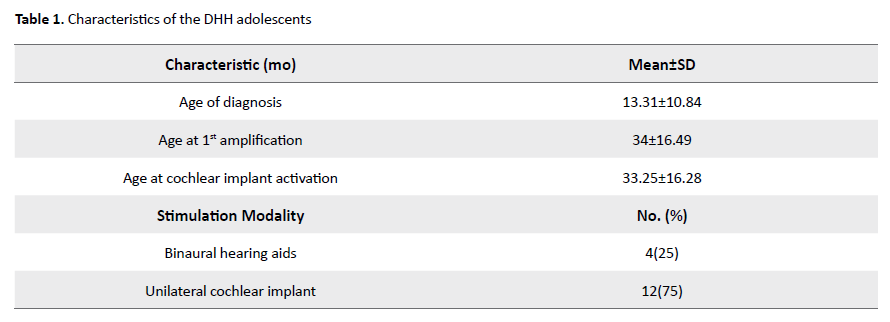
Children’s communication checklist (CCC)
The Persian version of the CCC was used to assess the pragmatic abilities of DHH and hearing adolescents [27]. The CCC-2 is intended to be filled out by an adult who frequently interacts with the child-typically a parent. The CCC can be used for children aged 5 to 16 years and covers the main pragmatic skills required for social communication. The 70 items are divided into nine subscales: a) Speech, b) Syntax, c) Inappropriate initiation, d) Coherence, e) Stereotyped language, f) Use of conversational context, g) Conversational rapport, h) Social relationships, and i) Interests [27].
The first two subscales: a) Speech, b) Syntax) Evaluate different areas of speech output and the syntax of expressive speech and language. The following five subscales: c) Inappropriate initiation, d) Coherence, e) Stereotyped language, f) Use of context, and g) Conversational rapport) focus on pragmatic communication skills. The final two subscales: h) Social relationships and i) Interests) evaluate behaviors that are typically deficient in autism spectrum disorder cases [27]. The total scores of the C-G subscales, which are related to pragmatic communication skills, make up the pragmatic composite score [28]. The internal consistency (α) of the Persian version of the CCC was between 0.75 and 0.84 [15].
Procedure
At first, according to the medical and demographic information completed by the parents (Appendix 1, Appendix 2), the clients who met the criteria for entering the study were determined. If the participants were willing to participate in the study, they first filled out a consent form and then the CCC. Parents were instructed by the researcher on how to respond to the CCC. The institution for supporting people with hearing loss in Tehran City, Iran provided a quiet room where the parents of each participant filled out this checklist.
Statistical analysis
The Mann-Whitney U test was used to examine differences between groups since the variances were uneven and the data were not equally distributed. Multiple comparisons were performed to identify the scale questions that contributed to the difference, and as a result, the significant P was reduced to 0.001 in these studies. Cronbach’s α was used to analyze CCC’s internal consistency. The SPSS software, version 26 was used for the data analysis.
Results
Comparison between two groups in the children’s communication checklist (CCC)
Table 2 presents the mean CCC scores for the two groups.
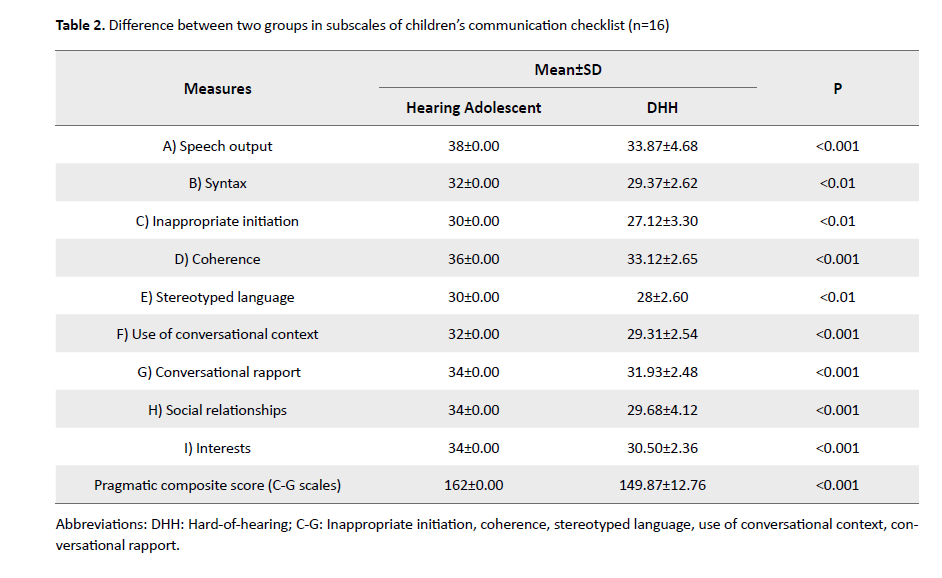
A significant difference was observed between the mean scores of speech output, syntax, inappropriate initiating, coherence, stereotyped language, use of conversational context, conversational rapport, social relationships, and interests between the two groups. The results of the Mann-Whitney U test illustrate that hearing adolescents had better scores than DHH adolescents in the CCC subscale scores.
Correlation between subscales C-G (inappropriate initiation, coherence, stereotyped language, use of conversational context, conversational rapport) in two groups
The correlation between subscales C-G was calculated, and the statistical results showed that in this study, the two subscales of inappropriate initiation and stereotyped language had the highest correlation (Table 3).
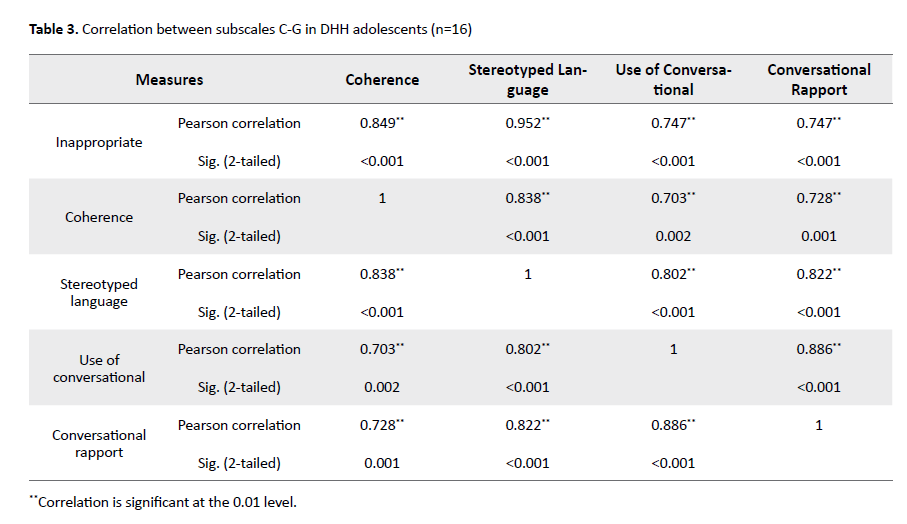
Correlation between pragmatic composite score and subscales C-G (inappropriate initiation, coherence, stereotyped language, use of conversational context, conversational rapport)
The correlation between pragmatic composite score and subscales showed that PCS has the most relationship with the stereotyped language subscale (Table 4).

Discussion
This study compared the pragmatic abilities of hearing and DHH adolescents. The DHH and hearing adolescents had significant differences in the CCC subscale scores. Both groups showed significant differences in each of the C-G subscales. DHH adolescents received lower scores than hearing adolescents in speech, syntax, inappropriate initiation, coherence, stereotyped language, use of context, conversational rapport, social relationship, and interest subscales. According to the results, the speech production and syntactic complexity of DHH adolescents were weaker than hearing adolescents. Therefore, DHH adolescents in pragmatic composite scores (C-G subscales) had lower scores than hearing adolescents. The results showed the highest correlation between five subscales, including inappropriate initiation, coherence, stereotyped language, use of context, and rapport, two subscales of inappropriate initiation and stereotyped language. Because the questions of these two subscales are related. The DHH adolescents had inappropriate initiation and stereotyped language in conversation with their partners. And also, the results showed that the correlation between the pragmatic composite score and stereotyped language had the highest rate, thus the stereotyped language subscale score had the most effects on PCS.
The results highlighted that DHH adolescents perform less in pragmatic skills than hearing adolescents. These results are consistent with previous research that demonstrated that DHH adolescents have a significant difference in pragmatic skills from hearing adolescents [1, 22, 24]. However, these results are inconsistent with the previous studies showing that DHH and hearing adolescents didn’t have a significant difference in communication skills [2, 3, 29].
Dammeyer conducted a longitudinal study of three DHH children with cochlear implants and discovered that cochlear implantation improves the ability to develop speech output and comprehension but shows problems in the ability to converse with smooth interchanges between conversational partners [24]. Also, the pragmatic skills of hearing and deaf students were compared, and the results showed that the profoundly deaf students had more difficulties using the proper pragmatic abilities in their conversations [22]. Most et al. used the pragmatic protocol to assess the pragmatic abilities of children with hearing loss and hearing children with identical language and chronological ages. According to the results, children with hearing loss had improper pragmatic abilities compared to hearing children [1].
Despite previous studies, Rezaei et al. assessed the pragmatic skills of the CI (cochlear implants), HA (hearing aid), and NH (normal hearing) participants using the Persian version of the CCC. The results showed that children with hearing impairment did not perform weaker in pragmatic skills than their hearing peers. Also, a significant variance was observed between NH and deaf children in speech output and syntax [3]. Additionally, using an 8-year follow-up, Aghaz et al examined the pragmatic abilities and speech intelligibility of Persian-speaking children with early and late cochlear implants. Despite considerable disparities in speech intelligibility, the data showed no differences in the development of crucial communication skills, especially pragmatic language [29].
The CCC, a parent evaluation tool, was used in the current study. Parents are required to complete the CCC. Some contend that parents sometimes tend to underrate or exaggerate their children’s abilities [2]. However, lots of research have demonstrated that parental evaluation is accurate and that parents may use it to evaluate their child’s speech and language abilities [29, 30]. Since parents interact with their children more than anyone else, they have a greater understanding of their skills and can assign appropriate grades. The CCC-Persian may be utilized as a valid clinical instrument to identify these issues for further evaluation and effective intervention [13]. Despite the small sample size, the results of the current study suggested that DHH adolescents may have pragmatic difficulties. This study suggests that it is critical to raise awareness to identify potential problems in DHH adolescents and discover effective solutions for their pragmatic difficulties.
Conclusion
The results of the CCC were different in DHH and hearing adolescents. The mean CCC scores of DHH adolescents were lower than those of hearing adolescents. Also, DHH adolescents show weaker performance in pragmatic skills than hearing adolescents. The pragmatic composite score had the highest correlation with the stereotyped language subscale. Two subscales, inappropriate initiation, and stereotyped language, had the strongest correlations with each other.
Ethical Considerations
Compliance with ethical guidelines
The Human Ethics Committee at the Iran University of Medical Sciences approved the present study (Code: IR. … .REC.1399.859).
Funding
This study was funded by the Iran University of Medical Sciences (Grant No.: 1400-3-6-22300).
Authors' contributions
All authors contributed equally in preparing all parts of the research.
Conflict of interest
The authors declared no conflict of interest.
Acknowledgments
The authors appreciate all participants and their parents who participated in the study and institution for supporting people with hearing loss.
References
Are DHH adolescents and hearing adolescents different in their pragmatic skills?
Which subscales in the CCC have the highest correlation with each other?
Pragmatic composite score (PCS) is most related to which subscales C-G (inappropriate initiation, coherence, stereotyped language, use of context, and conversational rapport)?
Materials and Methods
Thirty-two adolescents (18 girls and 14 boys) aged between 11-16 years participated in this study. Each group includes 9 girls and 7 boys separately. The Mean±SD chronological age of hearing adolescents was 13.60±2.43 and DHH adolescents were 13.90±2.10. Sixteen teenagers had hearing in the normal range while 16 others had DHH. All cochlear implant users reported profound hearing loss while adolescents using binaural hearing aids had mild to severe hearing loss. Parent reports provided the required data for the inclusion and exclusion of participants in this research. The inclusion criteria for the DHH group included that hearing loss must have started under two years of age. They were monolingual and spoke Persian. They attended regular classes with hearing adolescents, and they received at least 80 communication therapy sessions from a speech and language therapist after receiving a cochlear implant or hearing aids. The exclusion criteria for DHH adolescents included the use of sign language during conversations and the presence of additional neuromuscular, visual, or cognitive problems. Hearing adolescents were monolingual and spoke Persian. They spoke Persian as their first language and did not have any serious developmental impairments. At first, 40 DHH adolescents were selected, 17 of whom did not meet the inclusion criteria, and 7 adolescents were excluded from the study after being selected based on the inclusion criteria due to their unwillingness to cooperate and interact with an unfamiliar adult. Therefore, finally, 16 adolescents aged 11–16 years were included in the study.
Measures
Demographic questionnaire
The participants’ parents filled out this questionnaire (Appendix 1, Appendix 2). It gathered data on the parents’ hearing condition and the language used at home. Additionally, details on the child’s communication style, age at which the hearing loss was discovered, and degree of hearing loss were acquired. Table 1 presents the participant’s demographic data.

Children’s communication checklist (CCC)
The Persian version of the CCC was used to assess the pragmatic abilities of DHH and hearing adolescents [27]. The CCC-2 is intended to be filled out by an adult who frequently interacts with the child-typically a parent. The CCC can be used for children aged 5 to 16 years and covers the main pragmatic skills required for social communication. The 70 items are divided into nine subscales: a) Speech, b) Syntax, c) Inappropriate initiation, d) Coherence, e) Stereotyped language, f) Use of conversational context, g) Conversational rapport, h) Social relationships, and i) Interests [27].
The first two subscales: a) Speech, b) Syntax) Evaluate different areas of speech output and the syntax of expressive speech and language. The following five subscales: c) Inappropriate initiation, d) Coherence, e) Stereotyped language, f) Use of context, and g) Conversational rapport) focus on pragmatic communication skills. The final two subscales: h) Social relationships and i) Interests) evaluate behaviors that are typically deficient in autism spectrum disorder cases [27]. The total scores of the C-G subscales, which are related to pragmatic communication skills, make up the pragmatic composite score [28]. The internal consistency (α) of the Persian version of the CCC was between 0.75 and 0.84 [15].
Procedure
At first, according to the medical and demographic information completed by the parents (Appendix 1, Appendix 2), the clients who met the criteria for entering the study were determined. If the participants were willing to participate in the study, they first filled out a consent form and then the CCC. Parents were instructed by the researcher on how to respond to the CCC. The institution for supporting people with hearing loss in Tehran City, Iran provided a quiet room where the parents of each participant filled out this checklist.
Statistical analysis
The Mann-Whitney U test was used to examine differences between groups since the variances were uneven and the data were not equally distributed. Multiple comparisons were performed to identify the scale questions that contributed to the difference, and as a result, the significant P was reduced to 0.001 in these studies. Cronbach’s α was used to analyze CCC’s internal consistency. The SPSS software, version 26 was used for the data analysis.
Results
Comparison between two groups in the children’s communication checklist (CCC)
Table 2 presents the mean CCC scores for the two groups.

A significant difference was observed between the mean scores of speech output, syntax, inappropriate initiating, coherence, stereotyped language, use of conversational context, conversational rapport, social relationships, and interests between the two groups. The results of the Mann-Whitney U test illustrate that hearing adolescents had better scores than DHH adolescents in the CCC subscale scores.
Correlation between subscales C-G (inappropriate initiation, coherence, stereotyped language, use of conversational context, conversational rapport) in two groups
The correlation between subscales C-G was calculated, and the statistical results showed that in this study, the two subscales of inappropriate initiation and stereotyped language had the highest correlation (Table 3).

Correlation between pragmatic composite score and subscales C-G (inappropriate initiation, coherence, stereotyped language, use of conversational context, conversational rapport)
The correlation between pragmatic composite score and subscales showed that PCS has the most relationship with the stereotyped language subscale (Table 4).

Discussion
This study compared the pragmatic abilities of hearing and DHH adolescents. The DHH and hearing adolescents had significant differences in the CCC subscale scores. Both groups showed significant differences in each of the C-G subscales. DHH adolescents received lower scores than hearing adolescents in speech, syntax, inappropriate initiation, coherence, stereotyped language, use of context, conversational rapport, social relationship, and interest subscales. According to the results, the speech production and syntactic complexity of DHH adolescents were weaker than hearing adolescents. Therefore, DHH adolescents in pragmatic composite scores (C-G subscales) had lower scores than hearing adolescents. The results showed the highest correlation between five subscales, including inappropriate initiation, coherence, stereotyped language, use of context, and rapport, two subscales of inappropriate initiation and stereotyped language. Because the questions of these two subscales are related. The DHH adolescents had inappropriate initiation and stereotyped language in conversation with their partners. And also, the results showed that the correlation between the pragmatic composite score and stereotyped language had the highest rate, thus the stereotyped language subscale score had the most effects on PCS.
The results highlighted that DHH adolescents perform less in pragmatic skills than hearing adolescents. These results are consistent with previous research that demonstrated that DHH adolescents have a significant difference in pragmatic skills from hearing adolescents [1, 22, 24]. However, these results are inconsistent with the previous studies showing that DHH and hearing adolescents didn’t have a significant difference in communication skills [2, 3, 29].
Dammeyer conducted a longitudinal study of three DHH children with cochlear implants and discovered that cochlear implantation improves the ability to develop speech output and comprehension but shows problems in the ability to converse with smooth interchanges between conversational partners [24]. Also, the pragmatic skills of hearing and deaf students were compared, and the results showed that the profoundly deaf students had more difficulties using the proper pragmatic abilities in their conversations [22]. Most et al. used the pragmatic protocol to assess the pragmatic abilities of children with hearing loss and hearing children with identical language and chronological ages. According to the results, children with hearing loss had improper pragmatic abilities compared to hearing children [1].
Despite previous studies, Rezaei et al. assessed the pragmatic skills of the CI (cochlear implants), HA (hearing aid), and NH (normal hearing) participants using the Persian version of the CCC. The results showed that children with hearing impairment did not perform weaker in pragmatic skills than their hearing peers. Also, a significant variance was observed between NH and deaf children in speech output and syntax [3]. Additionally, using an 8-year follow-up, Aghaz et al examined the pragmatic abilities and speech intelligibility of Persian-speaking children with early and late cochlear implants. Despite considerable disparities in speech intelligibility, the data showed no differences in the development of crucial communication skills, especially pragmatic language [29].
The CCC, a parent evaluation tool, was used in the current study. Parents are required to complete the CCC. Some contend that parents sometimes tend to underrate or exaggerate their children’s abilities [2]. However, lots of research have demonstrated that parental evaluation is accurate and that parents may use it to evaluate their child’s speech and language abilities [29, 30]. Since parents interact with their children more than anyone else, they have a greater understanding of their skills and can assign appropriate grades. The CCC-Persian may be utilized as a valid clinical instrument to identify these issues for further evaluation and effective intervention [13]. Despite the small sample size, the results of the current study suggested that DHH adolescents may have pragmatic difficulties. This study suggests that it is critical to raise awareness to identify potential problems in DHH adolescents and discover effective solutions for their pragmatic difficulties.
Conclusion
The results of the CCC were different in DHH and hearing adolescents. The mean CCC scores of DHH adolescents were lower than those of hearing adolescents. Also, DHH adolescents show weaker performance in pragmatic skills than hearing adolescents. The pragmatic composite score had the highest correlation with the stereotyped language subscale. Two subscales, inappropriate initiation, and stereotyped language, had the strongest correlations with each other.
Ethical Considerations
Compliance with ethical guidelines
The Human Ethics Committee at the Iran University of Medical Sciences approved the present study (Code: IR. … .REC.1399.859).
Funding
This study was funded by the Iran University of Medical Sciences (Grant No.: 1400-3-6-22300).
Authors' contributions
All authors contributed equally in preparing all parts of the research.
Conflict of interest
The authors declared no conflict of interest.
Acknowledgments
The authors appreciate all participants and their parents who participated in the study and institution for supporting people with hearing loss.
References
- Most T, Shina-August E, Meilijson S. Pragmatic abilities of children with hearing loss using cochlear implants or hearing AIDS compared to hearing children. J Deaf Stud Deaf Educ. 2010; 15(4):422-37. [DOI:10.1093/deafed/enq032] [PMID]
- Socher M, Lyxell B, Ellis R, Gärskog M, Hedström I, Wass M. Pragmatic language skills: A comparison of children with cochlear implants and children without hearing loss. Front Psychol. 2019; 10:2243. [DOI:10.3389/fpsyg.2019.02243] [PMID] [PMCID]
- Rezaei M, Rashedi V, Borhaninejad V, Nurian ZS. Pragmatic skills in children with hearing loss: Comparison between cochlear implants and hearing Aids users. Indian J Otolaryngol Head Neck Surg. 2022; 74(3):434-438. [DOI:10.1007/s12070-021-02529-5] [PMID]
- Goberis D, Beams D, Dalpes M, Abrisch A, Baca R, Yoshinaga-Itano C. The missing link in language development of deaf and hard of hearing children: Pragmatic language development. Semin Speech Lang. 2012; 33(4):297-309. [DOI:10.1055/s-0032-1326916] [PMID]
- Toe D, Paatsch L, Szarkowski A. Assessing pragmatic skills using checklists with children who are deaf and hard of hearing: A systematic review. J Deaf Stud Deaf Educ. 2019; 24(3):189-200. [DOI:10.1093/deafed/enz004] [PMID]
- Longobardi E, Lonigro A, Laghi F, O’Neill DK. Pragmatic language development in 18-to 47-month-old Italian children: A study with the Language Use Inventory. First Lang. 2017; 37(3):252-66. [DOI:10.1177/0142723716689273]
- Loukusa S, Leinonen E, Ryder N. Development of pragmatic language comprehension in Finnish-speaking children. First Lang. 2007; 27(3):279-96. [DOI:10.1177/0142723707076568]
- Hoff E. Language development. Boston: Cengage Learning; 2013. [Link]
- Ciocci SR, Baran J. The use of conversational repair strategies by children who are deaf. Am Ann Deaf. 1998; 143(3):235-45. [DOI:10.1353/aad.2012.0129] [PMID]
- Cummings L. Research in clinical pragmatics. Springer; 2017. [Link]
- Prutting CA, Kittchner DM. A clinical appraisal of the pragmatic aspects of language. J Speech Hear Disord. 1987; 52(2):105-19. [DOI:10.1044/jshd.5202.105] [PMID]
- Cummings L. The Routledge pragmatics encyclopedia. London: Routledge; 2010. [DOI:10.4324/9780203873069]
- Bishop DV. Development of the Children’s Communication Checklist (CCC): A method for assessing qualitative aspects of communicative impairment in children. J Child Psychol Psychiatry. 1998; 39(6):879-91. [DOI:10.1111/1469-7610.00388] [PMID]
- Zaidman-Zait A, Dotan A. Everyday stressors in deaf and hard of hearing adolescents: The role of coping and pragmatics. J Deaf Stud Deaf Educ. 2017; 22(3):257-68. [DOI:10.1093/deafed/enw103] [PMID]
- Kazemi Y, Afsharianzadeh E, Mirzaei B, Baghbani M, Gheleyempour L, Najarzade M. The children’s communication checklist (ccc): a study on Iranian children. J Res Rehabil Sci. 2007; 2(3):1-5. [Link]
- Navideh A, Yalda K, Laya Gholami T, Elham A. Content validity of Persian version of children’s communication checklist for Iranian four to six year-old children. J Lang Commun Disord. 2015; 4(1):9-11. [Link]
- Kennedy CR, McCann DC, Campbell MJ, Law CM, Mullee M, Petrou S, et al. Language ability after early detection of permanent childhood hearing impairment. N Engl J Med. 2006; 354(20):2131-41. [DOI:10.1056/NEJMoa054915] [PMID]
- Watkin P, McCann D, Law C, Mullee M, Petrou S, Stevenson J, et al. Language ability in children with permanent hearing impairment: The influence of early management and family participation. Pediatrics. 2007; 120(3):e694-e701. [DOI:10.1542/peds.2006-2116] [PMID]
- Theunissen SC, Rieffe C, Kouwenberg M, De Raeve LJ, Soede W, Briaire JJ, et al. Behavioral problems in school-aged hearing-impaired children: The influence of sociodemographic, linguistic, and medical factors. Eur Child Adolesc Psychiatry. 2014; 23(4):187-96. [DOI:10.1007/s00787-013-0444-4] [PMID]
- Matthews D, Kelly C. Pragmatic development in deaf and hard of hearing children: A review. Deafness Edu Int. 2022; 1-18. [DOI:10.1080/14643154.2022.2140251]
- Thagard EK, Hilsmier AS, Easterbrooks SR. Pragmatic language in deaf and hard of hearing students: Correlation with success in general education. Am Ann Deaf. 2011; 155(5):526-34. [DOI:10.1353/aad.2011.0008] [PMID]
- Jeanes RC, Nienhuys TG, Rickards FW. The pragmatic skills of profoundly deaf children. J Deaf Stud Deaf Educ. 2000; 5(3):237-47. [DOI:10.1093/deafed/5.3.237] [PMID]
- Paatsch LE, Toe DM. A comparison of pragmatic abilities of children who are deaf or hard of hearing and their hearing peers. J Deaf Stud Deaf Educ. 2014; 19(1):1-19. [DOI:10.1093/deafed/ent030] [PMID]
- Dammeyer J. A longitudinal study of pragmatic language development in three children with cochlear implants. Deaf Educ Int 2012; 14(4):217-32. [DOI:10.1179/1464315412Z.00000000024]
- Toe D, Beattie R, Barr M. The development of pragmatic skills in children who are severely and profoundly deaf. Deafness Educ Int. 2007; 9(2):101-17. [DOI:10.1179/146431507790560011]
- Chen HV. Pragmatic skills intervention: Understanding pragmatic differences, communication breakdown management, peer & self attitudes and perceptions in children with hearing loss [MSc. thesis]. Texas: University of Texas; 2014. [Link]
- Bishop D. Children’s Communication Checklist-Second Edition. London: The Psychological Corporation; 2003. [Link]
- Bishop DV, Baird G. Parent and teacher report of pragmatic aspects of communication: Use of the Children’s Communication Checklist in a clinical setting. Dev Med Child Neurol. 2001; 43(12):809-18. [DOI:10.1017/S0012162201001475] [PMID]
- Aghaz A, Kazemi Y, Hemmati E, Zarifian T. [Psychometric properties of Persian Version of Intelligibility Context Scale in Persian-speaking children (Persian)]. Sci J Rehabil Med. 2022; 10(6):1270-83. [DOI:10.32598/SJRM.10.6.22]
- McLeod S, Harrison LJ, McCormack J. The intelligibility in context scale: Validity and reliability of a subjective rating measure. J Speech Lang Hear Res. 2012; 55(2):648-56 [DOI:10.1037/t35980-000


.png)
Type of Study: Research |
Subject:
Speech Therapy
Received: 2023/06/11 | Accepted: 2023/07/22 | Published: 2023/02/6
Received: 2023/06/11 | Accepted: 2023/07/22 | Published: 2023/02/6








